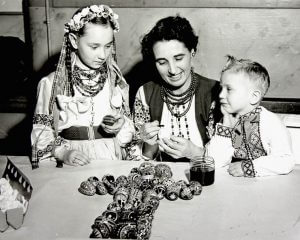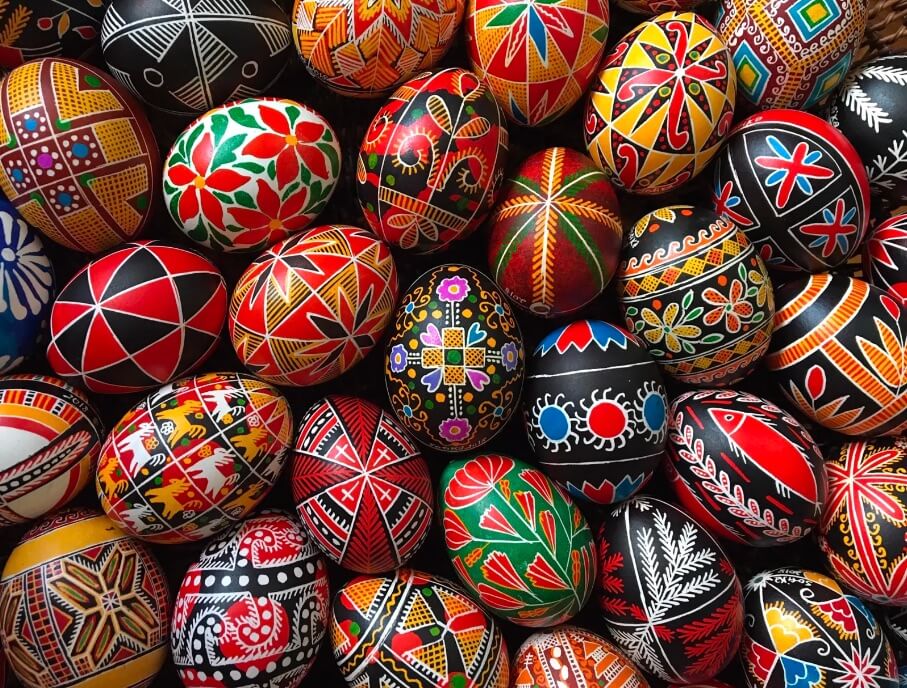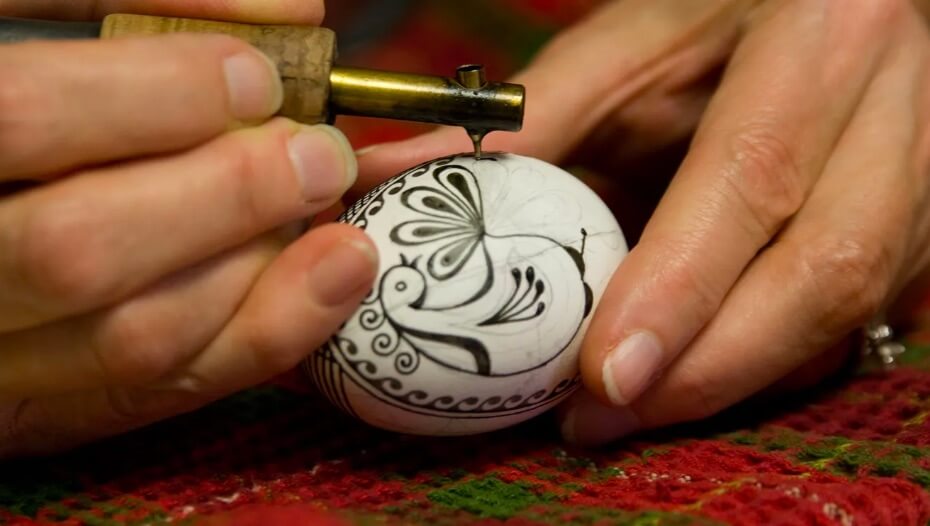A Ukrainian tradition dating back to ancient times, the pysanka has long served as a symbol of hope.
The pysanka – a traditional Ukrainian decorated egg – is an important feature of Ukrainian cultural heritage holding many symbolic attributes and magical virtues. For true appreciation of the pysanka and what it means for Ukrainian people, let’s look further into the history of these eggs.
Legends and Folklore of the Pysanka
One legend dating back to the pre-Christian era links the tradition of making a pysanka to a story about holding back evil. Folklore had it that a monster who embodied evil terrorized the people of the Carpathian Mountains (what is now Western Ukraine). The monster threatened to destroy the entire world were it not for the townspeople’s production of pysanky (plural of pysanka). According to the legend, the more pysanky produced, the tighter the chains wrapped around the monster, holding him at bay.

Pysanky are given to friends and loved ones to represent the gift of life, and are usually decorated to match the personality of the receiver. Photo by St Volodymyr Cultural Center.
Other pre-Christian allegories related the egg with the power of the sun. This connection is multi-layered. On the most basic level, the yellow yolk of the egg was reminiscent of the sun. Further allegory is seen in the bird’s ability to fly, which was thought to bring them closer to the sun than any mortal on earth. Holding a pysanka in one’s hand was seen as being akin to possessing such power.
Further connections between the egg and the sun were seen in the egg’s capacity to hatch a rooster – the sun god’s chosen creature with the ability to make the sun rise after a long night and a dark winter. Finally, the decoration on pysanky provided the rare opportunity for the pysankarka (the pysanka maker) to connect with the sun god – the patterns acting as messages, prayers, and tributes.

These visually stunning pysanky may be recognised by their bright colors and complex floral motifs, which are often geometric in form. Photo by Sofika Zielyk.
Symbols and Motifs in Practice
The process of decorating the egg is not by painting, as it may appear, but by an artistic practice of ‘writing’ intricate designs upon the surface of the shell. The word pysanka is a derivation of the Ukrainian verb pysaty, meaning ‘to write’.
The motifs are written upon each egg with melted beeswax and stylus (kistka). The egg is then dyed, and the process is repeated until multiple layers of the wax-resistant patterns and colors come together to create the desired result. Different regions of Ukraine have their own traditions when it comes to decorating, with different motifs suggestive of different meanings, including fertility, strength, and prosperity.

The practice of decorating pysanky is delicate, as the patterns and designs are written on the eggs with beeswax rather than painted. Photo by Tom Baugues.
An Easter Tradition
Connections between eggs and rebirth later became assigned to Christian traditions following the Christianization of what is now Ukraine in the 9th and 10th centuries. The pysanky soon became associated with Easter, resurrection of Christ, and good omens. Traditions around pysanky evolved, including placing the eggs in beehives (the rounded form of the pysanky conveying a continuous supply of honey), adding eggs to the four corners of a newly built house to protect the structure against evil spirits, and mixing the eggshells into the cattle feed and soil for stronger cattle and a better harvest.
This connection to Easter is what almost led to the eradication of the cultural tradition. Under Stalin many religious customs were banned, including the making of the pysanky. However, the artistic practice survived thanks in part to the many Ukrainians who emigrated across the world in the late 19th and early 20th centuries.
A Heralded Heritage
Today, pysanky are made by Ukrainians the world over, united in their heritage and their craftsmanship. A museum in Kolomyia, Ukraine is dedicated to the pysanka, with over 10,000 examples in their collection, some nearly a century old.

The Pysanka Museum in Kolomyia is the largest pysanka in the world and the only museum in the world whose exposition is devoted to the art of writing Easter eggs. Photo by Scott Prokop.
Recent efforts following the war between Russia and Ukraine have led to a resurgence of the important cultural custom as a sign of strength and resistance, an amulet against evil, and a harbinger of good. The tradition has gained further significance as several charities have worked to produce and sell pysanky to benefit humanitarian efforts in Ukraine.
Global Heritage Fund’s collaboration with Celemeta, an open-metaverse world that allows individuals and decentralized governance organizations to jointly manage and build a virtual and constantly evolving world, stands as a unique campaign, offering pysanky NFTs to Ukraine’s cultural workers who continue, without salaries, to protect Ukrainian cultural heritage and art.

